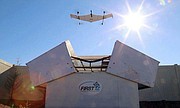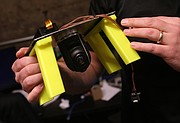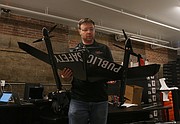Speedy drones to assist local first responders
COEUR d’ALENE — First responders in the area may soon have the benefit of visual information at the scene, before they arrive on the scene.
Currently fire departments, police, and other first responders have to arrive on the scene first and then launch their own drones to get video and photos from overhead. Until they get to the scene, the first responders are flying blind.
As xCraft CEO and co-founder JD Claridge explained Friday, First iZ will change all that.
An emergency dispatcher will be able to press a button that results in a specially designed drone launching 10 seconds later and flying to the scene of the incident within five minutes. A $15,000 HD camera aboard the drone will feed video to first responders en route to the call, Claridge said.
The Coeur d’Alene-based drone company is testing its First iZ system at the Coeur d’Alene Fire Department’s Station 4 on Atlas Road. Fire department spokesman Craig Etherton said the possibilities are “exciting.”
“We’re happy to be partnering with them on a project that should hopefully have some real positive gains for first responders in our area,” said Etherton.
Claridge said he’s very grateful for the support that the project has received from the city, mayor, and local community.
The idea is for cities to sign up for the First iZ system, and for multiple drones to be installed around the municipality. Each drone is housed in a climate-controlled port, covered with a lid. Upon command from the dispatcher, First iZ software will compute which drone is nearest the scene of the incident, calculate a flight plan, submit it to the Federal Aviation Administration, tell the drone’s port to open, and launch the drone.
Each First iZ drone is designed to take off vertically like a helicopter and then fly horizontally like an airplane. Claridge said he designed the drones to be able to launch even in windy conditions with 30-40 mph gusts. Snow, rain, and maybe even hail won’t ground them, he said.
Claridge said the drones can fly at speeds of 60-70 mph for up to an hour, thanks to their design.
The drones are also designed with multiple safety systems to ensure that nobody on the ground needs fear them. They have multiple power systems and multiple auto-pilot systems just like passenger aircraft, said Claridge, who is both a pilot and an engineer with years of experience in the aviation industry. There’s even a fail-safe parachute that will deploy if all else goes wrong, he said.
The drones will fly at 200-400 feet up and be visually distinct with their wing shape and “public safety” markings. They’ll also have flashing red and blue emergency lights, said Claridge.
Claridge said the drones will handle video footage the same way bodycam videos on police officers are handled.
“The public in general just wants to know they’re not being spied on, and that’s not our intent. We want to keep them safe and give first responders the tools to do that,” he said.
Access to the video footage will be limited to certain first responders and will not be freely available, he said.
“This is to help you,” Claridge said. “You’ll want this on scene to help firefighters if your house is burning so they can save it.”
No one else in the UAV space is doing this, said Claridge. Patents are pending on the concept.
Two drones are also being tested now in Tyler, Texas, the home of Claridge’s friend and xCraft co-founder Phil Burks. Burks has designed software for dispatchers to help ambulances respond to emergency locations faster. First iZ is the result of combining Burks’ software and Claridge’s hardware.
A proof of concept for the system will be conducted in several months, said Claridge.
He hopes to have 30-50 drones installed around the Inland Northwest and elsewhere, and to conduct beta testing for the next year. Those drones will be dispatched but need to stay within the line of sight of their operators, he said. FAA regulations limit drones to the line of sight of their users, he explained. That, plus other FAA regulations limiting night flights and flying over people, are issues he wants to work on with the FAA.
In several years Claridge hopes to have a few hundred drones fully functioning on behalf of cities around the nation. Municipalities will pay a monthly fee to cover the hardware, software, video and maintenance, said Claridge.
Which way did the bad guy go? How big is the fire? What’s traffic look like on the way? These are questions First iZ will help answer for first responders, said Claridge.
“It’ll help them respond faster and help them save lives, for sure,” he said.







